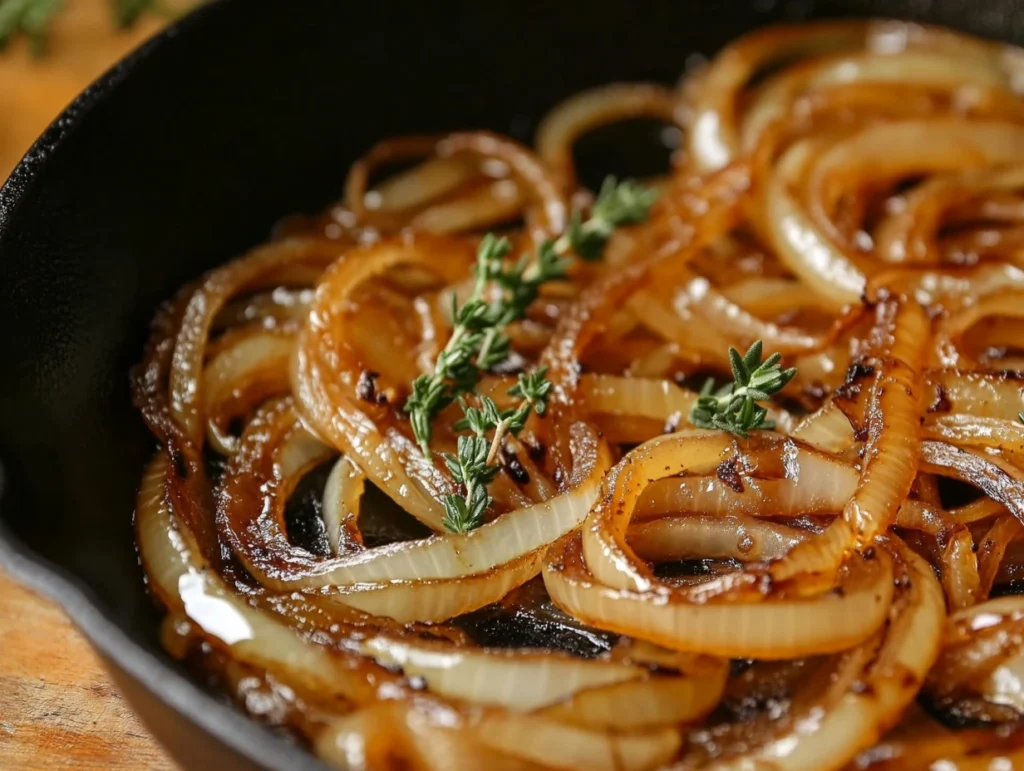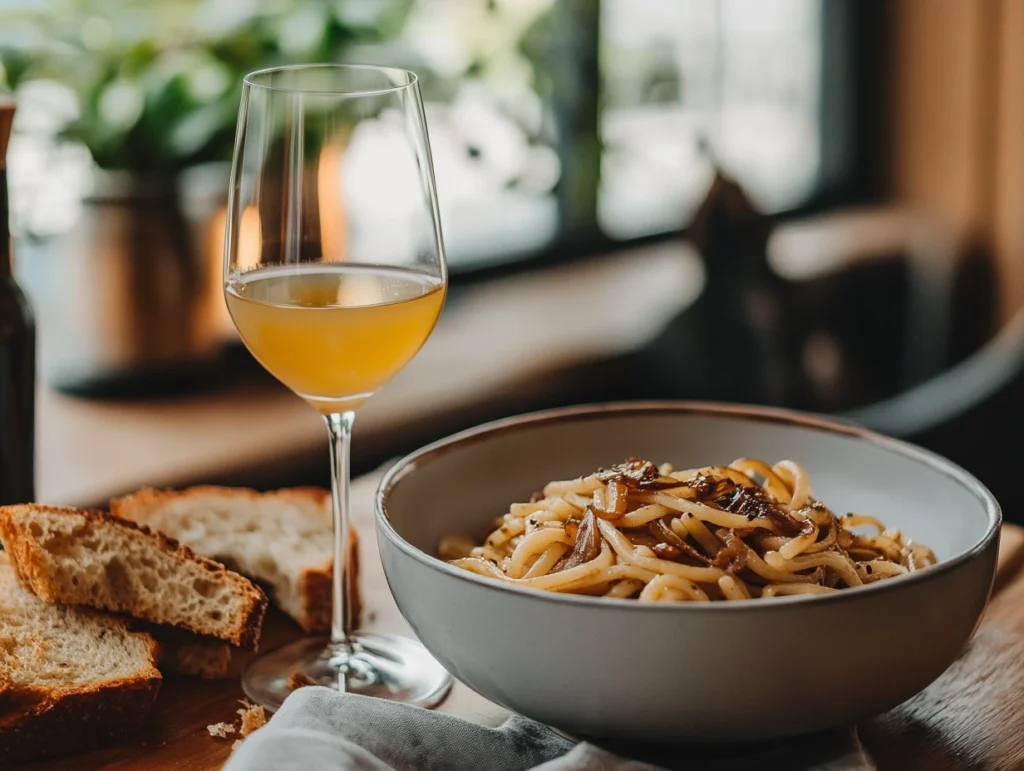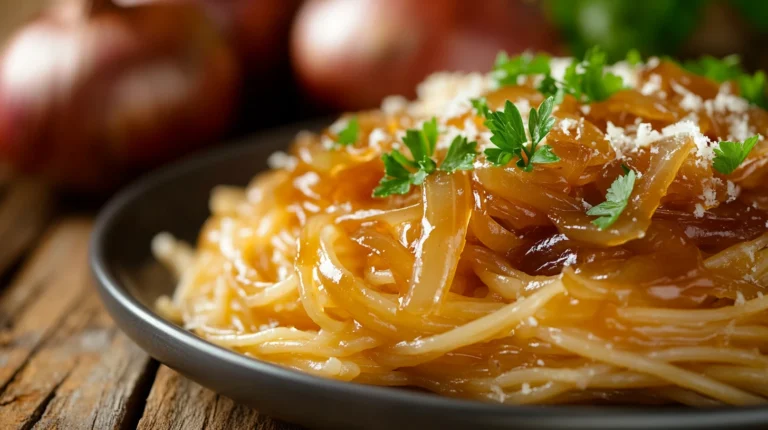Crafting a perfect caramelized onion pasta is like weaving together simplicity and elegance on a plate. This dish is a testament to how just a few humble ingredients can transform into something magical when cooked with love and attention. From the sweetness of slow-cooked onions to the earthy aroma of herbs and the satisfying bite of al dente pasta, every element plays a role. In this article, you’ll learn the secrets to mastering this dish, explore creative variations, and discover tips to make it your own. So, let’s dive in!
What is Caramelized Onion Pasta?
The rich and velvety caramelized onion pasta is a culinary masterpiece that combines pasta with the deeply sweet, nutty, and savory flavor of onions cooked to golden perfection. While onions are a staple in countless dishes, their caramelized version elevates this dish to an irresistible delight. With a few pantry staples and the right techniques, anyone can recreate this restaurant-worthy meal at home.
Why Caramelized Onions Shine in Pasta Dishes
Caramelized onions are like a secret weapon for pasta dishes. When onions are slowly cooked over low heat, their natural sugars break down, turning them soft, golden, and irresistibly sweet. This flavor pairs beautifully with pasta, creating a comforting dish that’s hearty yet light. Not to mention, the texture of the onions adds a silky richness that clings to the pasta strands like a dream.
Key Ingredients for the Perfect Caramelized Onion Pasta
Achieving a memorable caramelized onion pasta begins with quality ingredients. Here’s what you’ll need:
- Onions: Yellow onions are the go-to choice due to their natural sweetness. Red onions offer a slightly sharper, tangy flavor.
- Pasta: Spaghetti, linguine, or penne work best, but you can experiment with what you have on hand.
- Olive Oil or Butter: Essential for caramelizing the onions. For a vegan twist, use olive oil exclusively.
- Seasonings: Salt and freshly ground black pepper are non-negotiable, while thyme, bay leaves, or a pinch of chili flakes add depth.
- Cheese (Optional): Parmesan or pecorino adds a salty, creamy touch.
Optional add-ins like mushrooms, spinach, or even chickpeas can take this dish in an exciting new direction.
Choosing the Best Pasta for Caramelized Onion Sauce
Not all pasta shapes are created equal when it comes to pairing with caramelized onions. Long strands like spaghetti and linguine are excellent for wrapping the silky sauce, while tubular shapes like penne capture the onions in every bite. If you’re feeling adventurous, fresh handmade pasta brings an even more luxurious texture.
Understanding the Art of Caramelization
The process of caramelizing onions is all about patience. It’s not a task to rush. Onions need to be cooked low and slow for at least 25–30 minutes to achieve that golden-brown hue and a complex, sweet-savory flavor. Stirring occasionally, allowing bits to stick and scrape, and watching the transformation are all part of the process.
- Tip: Adding a splash of water or broth mid-way prevents sticking and encourages even cooking.
Variations of Caramelized Onion Pasta
This dish is endlessly versatile. You can tailor it to suit dietary preferences or simply to mix up the flavors.
- Vegan: Use olive oil instead of butter and skip the cheese. Nutritional yeast is a fantastic alternative for a cheesy hint.
- Protein Boost: Grilled chicken, shrimp, or tofu makes it a more filling meal.
- Vegetable-Packed: Add sautéed zucchini, roasted cherry tomatoes, or caramelized fennel for a burst of color and nutrition.
The Role of Aromatics in Enhancing Flavor
Aromatics like garlic, thyme, and bay leaves are subtle yet powerful additions to caramelized onion pasta. Garlic brings a fragrant depth, thyme offers an earthy warmth, and bay leaves introduce a slightly floral undertone. Don’t skip them if you want a truly unforgettable flavor profile.
Complementary Sauces for Caramelized Onion Pasta
While caramelized onions create their own sauce when combined with olive oil and pasta water, you can experiment with complementary sauces:
- Cream-Based: A splash of cream turns the dish into a decadent treat.
- Tomato-Based: A dollop of sun-dried tomato paste adds tangy brightness.
- Olive Oil Sauce: A generous drizzle of high-quality extra virgin olive oil keeps things simple yet flavorful.
Health Benefits of Onions in This Dish
Believe it or not, onions aren’t just delicious—they’re nutritious too. Rich in antioxidants, vitamins, and minerals, they support heart health, boost immunity, and promote good digestion. Eating caramelized onion pasta is a comforting yet health-conscious choice.
Step-by-Step Guide to Making Caramelized Onion Pasta
Preparing the Onions for Caramelized Onion Pasta

The secret to a flawless caramelized onion pasta starts with the onions. Choosing the right variety and preparing them correctly is key.
- Select Your Onions: Yellow onions are preferred for their balance of sweetness and acidity, but red onions can bring a more robust flavor.
- Slice Thinly: Use a sharp knife or mandoline to achieve uniform slices, ensuring they cook evenly.
- Heat the Pan: A wide skillet works best. Add a mix of olive oil and butter for richness or stick to olive oil for a vegan version.
- Low and Slow: Keep the heat at medium-low and add the onions. Stir occasionally, allowing them to cook down for 25–30 minutes.
- Pro Tip: Sprinkle a pinch of salt at the start. It draws out the moisture and speeds up caramelization.
Cooking the Pasta Perfectly
While the onions cook, it’s time to prepare the pasta. The goal is perfectly cooked noodles that absorb the flavors of the sauce.
- Boil Water: Use a large pot with plenty of salted water. The salt should mimic the taste of the sea.
- Cook to Al Dente: Follow the package instructions, but reduce the time slightly. Remember, the pasta will continue cooking when mixed with the sauce.
- Reserve Pasta Water: Save about a cup of the starchy water before draining the pasta. It’s liquid gold for binding the sauce.
Balancing Flavors in Caramelized Onion Pasta
The combination of sweet onions, savory pasta, and aromatic seasonings requires balance. Here’s how to perfect it:
- Season Thoughtfully: Taste as you go, adding salt and pepper gradually.
- Brighten with Acid: A squeeze of lemon juice or a splash of balsamic vinegar cuts through the sweetness.
- Enhance with Cheese: Grate some parmesan or pecorino for added umami.
Adding Proteins or Vegetables
To make your caramelized onion pasta more substantial, consider these delicious additions:
- Proteins: Grilled chicken, turkey sausage, or even pan-seared tofu work beautifully.
- Vegetables: Sautéed spinach, roasted mushrooms, or charred zucchini add color and nutrition.
Finishing Touches for Caramelized Onion Pasta
Once the onions are caramelized and the pasta is cooked, it’s time to bring everything together.
- Combine: Toss the cooked pasta into the skillet with the onions. Add a splash of reserved pasta water to create a silky sauce.
- Season to Perfection: Adjust salt, pepper, and any aromatics like thyme or garlic.
- Garnish: Sprinkle with fresh parsley, a pinch of red chili flakes, or a handful of toasted breadcrumbs for texture.
- Pro Tip: Let the pasta sit for a minute or two before serving to allow the flavors to meld.
Making It Gluten-Free
For those avoiding gluten, caramelized onion pasta can easily be adapted:
- Use Gluten-Free Pasta: Choose from rice, quinoa, or chickpea-based pasta varieties.
- Check Labels: Ensure all sauces or seasonings are certified gluten-free.
Vegan Adaptation of Caramelized Onion Pasta
Creating a vegan version is simple yet satisfying. Replace butter with olive oil or a plant-based alternative. Use nutritional yeast or vegan cheese to replicate the cheesy notes. Additionally, roasted chickpeas or vegan sausages can boost protein content without sacrificing flavor.
Serving Suggestions for Caramelized Onion Pasta

A plate of caramelized onion pasta deserves thoughtful sides. Pair it with:
- Fresh Salads: A crisp, tangy side salad complements the richness of the pasta.
- Bread Options: Serve with crusty garlic bread or gluten-free flatbreads for dipping.
- Beverages: Keep it simple with sparkling water or lemonade.
Common Mistakes to Avoid
Even the most straightforward recipes can go awry. Avoid these pitfalls when making caramelized onion pasta:
- Rushing the Onions: High heat burns onions before they caramelize, so patience is vital.
- Overcooking the Pasta: Mushy pasta won’t hold up in this dish. Aim for a firm bite.
- Neglecting Seasoning: Always taste and adjust throughout the cooking process.
Quick Hacks for Busy Cooks
When time is short, but cravings strike, these hacks come in handy:
- Pre-Caramelized Onions: Many stores sell pre-cooked onions that save time.
- One-Pot Pasta: Cook pasta directly in broth and add caramelized onions toward the end.
- Meal Prep: Caramelize a large batch of onions ahead of time and freeze portions for later use.
Culinary Enhancements and Beyond
Regional Twists on Caramelized Onion Pasta
Every cuisine has its own take on caramelized onion pasta, infusing it with local flavors and techniques:
- Italian Influence: Incorporate fresh basil and a splash of tomato passata for a Mediterranean touch.
- French Flair: Add a hint of Dijon mustard and crème fraîche for a creamy, tangy variation.
- Middle Eastern Fusion: Include a sprinkle of za’atar and toasted pine nuts for a nutty, herbaceous twist.
The History of Pasta and Onions
Pasta and onions have been culinary partners for centuries, rooted in humble, peasant-style cooking. While the exact origins of caramelized onion pasta are unclear, the pairing speaks to the ingenuity of cooks who transformed simple ingredients into something extraordinary. Over time, this dish has become a beloved comfort food, blending tradition with modern creativity.
Exploring Textures in Caramelized Onion Pasta
Texture is an essential component of this dish, balancing softness with a hint of crunch:
- Crunchy Toppings: Add toasted breadcrumbs or crushed nuts for contrast.
- Silky Sauce: The combination of pasta water and caramelized onions creates a luxurious base.
- Optional Vegetables: Charred or roasted vegetables provide a satisfying bite.
Using Specialty Cheeses for a Creamier Dish
Though parmesan is a classic choice, experimenting with different cheeses can elevate the dish:
- Goat Cheese: Creamy and tangy, it melts beautifully into the sauce.
- Gorgonzola: For those who enjoy bold, pungent flavors.
- Ricotta: Offers a mild, fluffy texture that balances the sweetness of the onions.
Each cheese brings its own personality to caramelized onion pasta, making it easy to customize based on taste preferences.
Seasonal Variations of Caramelized Onion Pasta
This versatile dish can adapt to the seasons, ensuring it’s a year-round favorite:
- Summer: Add fresh cherry tomatoes, basil, or a touch of lemon zest for brightness.
- Autumn: Incorporate roasted butternut squash or sage for a cozy feel.
- Winter: Opt for hearty additions like kale, mushrooms, or even a touch of truffle oil.
- Spring: Use tender asparagus tips or peas for a fresh, green flavor profile.
Kid-Friendly Modifications
Kids often prefer milder flavors, so tweak the recipe to suit their tastes:
- Reduce Sweetness: Cook the onions slightly less to keep their flavor balanced.
- Cheesy Appeal: Add extra cheese to make the dish creamy and irresistible.
- Playful Shapes: Use fun pasta shapes like bow ties or spirals to make the meal more appealing.
Budget-Friendly Options for Caramelized Onion Pasta
This dish proves that gourmet doesn’t have to mean expensive. With a few budget-conscious adjustments, you can enjoy caramelized onion pasta without breaking the bank:
- Use Pantry Staples: Stick to basic pasta and onions while skipping optional add-ins.
- Homemade Alternatives: Make your own breadcrumbs or substitute cheese with nutritional yeast.
- Buy in Bulk: Onions and pasta are often cheaper when purchased in larger quantities.
Hosting a Pasta Night Featuring Caramelized Onion Pasta
Want to impress guests? Hosting a pasta night with caramelized onion pasta as the star is a surefire way to wow them. Here’s how to plan it:
- Menu Pairings: Serve alongside a crisp Caesar salad, roasted vegetables, or a light soup.
- Customization Bar: Offer toppings like grated cheeses, chili flakes, or fresh herbs.
- Presentation Matters: Plate the pasta in wide bowls with garnishes to elevate the aesthetic.
Storing and Reheating Tips for Caramelized Onion Pasta
Leftovers? Lucky you! Proper storage ensures the flavors remain intact:
- Refrigerate: Store in an airtight container for up to 3 days.
- Reheat: Use a skillet to warm the pasta gently, adding a splash of water or broth to revive the sauce.
- Freeze: Caramelized onions can be frozen separately, making meal prep quicker in the future.
Advanced Cooking Techniques
Take your caramelized onion pasta to the next level with these advanced methods:
- Sous-Vide Onions: Cook onions in a sous-vide setup for consistent, deeply caramelized results.
- Pressure Cooker: Speed up the caramelization process using a pressure cooker for time savings.
- Fusion Flavors: Experiment with unexpected spices like curry powder or soy sauce for a bold twist.
FAQs About Caramelized Onion Pasta
What is the trick to caramelizing onions?
The key to perfectly caramelized onions lies in patience and proper technique. Use low to medium heat and allow the onions to cook slowly. Stir occasionally, but not too often, to let them develop a rich, golden color. Adding a pinch of salt at the start helps draw out moisture, while a splash of water or broth mid-way prevents burning. A mix of butter and oil provides the best balance of flavor and browning.
Are caramelized onions good in spaghetti sauce?
Absolutely! Caramelized onions add a sweet, savory depth to spaghetti sauce. Whether it’s a classic marinara or a cream-based sauce, the natural sweetness of caramelized onions enhances the flavor complexity. They also work beautifully in olive oil-based sauces, adding a silky texture that pairs well with the pasta.
What goes well with caramelized onions?
Caramelized onions are incredibly versatile and pair well with a variety of ingredients:
- Proteins: Chicken, turkey, tofu, or even lentils.
- Vegetables: Mushrooms, spinach, zucchini, or roasted peppers.
- Cheeses: Parmesan, goat cheese, gorgonzola, or ricotta.
- Herbs and Spices: Thyme, rosemary, or a pinch of chili flakes for heat.
Their sweet, savory flavor profile complements just about any dish!
Do onions caramelize better with butter or oil?
A combination of butter and oil works best for caramelizing onions. Butter provides a rich, nutty flavor, while oil prevents the butter from burning due to its higher smoke point. If you prefer a vegan option, olive oil alone works beautifully, offering a fruity undertone to the caramelized onions.
Can I freeze caramelized onions for later use?
Yes, you can freeze caramelized onions! They store well in an airtight container or freezer bag for up to three months. This makes them a convenient addition to recipes like caramelized onion pasta or soups when you’re short on time.
What’s the best way to reheat caramelized onion pasta?
Reheat your pasta gently in a skillet over low heat. Add a splash of water, broth, or olive oil to refresh the sauce. Avoid using a microwave, as it can dry out the pasta and compromise the texture of the onions.
Conclusion
Caramelized onion pasta is more than just a meal—it’s an experience that showcases the beauty of simple, wholesome ingredients. By mastering the art of caramelizing onions and exploring endless variations, you can transform this humble dish into a culinary highlight that satisfies every palate. Whether you’re preparing a quick weeknight dinner or impressing guests with your cooking skills, this recipe delivers every time. Happy cooking!


4 thoughts on “Caramelized Onion Pasta: A Flavorful Journey”
Comments are closed.